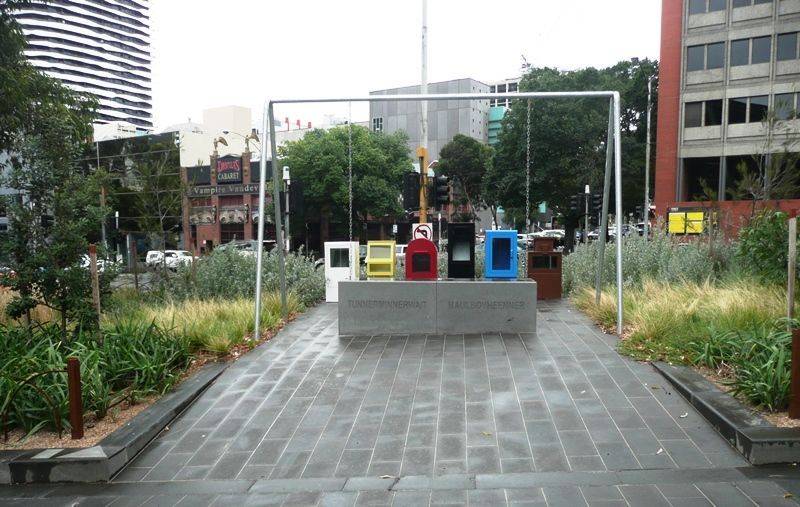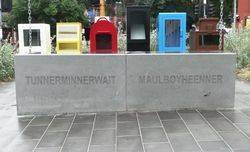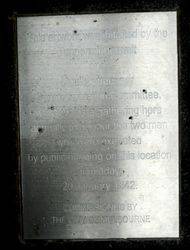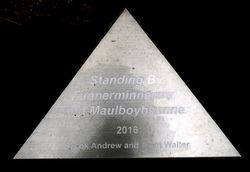
Standing By Tunnerminnerwait & MaulboyheennerPrint Page 
The public artwork commemorates Tunnerminnerwait and Maulboyheenner, two Tasmanian Aboriginal men who were publicly hanged in Melbourne in 1842. It marks a period in Victoria’s history when Koorie peoples were forcefully expelled from their lands.
Standing by Tunnerminnerwait and Maulboyheenner is a permanent marker that is experimental and empowering. It begs contemporary viewers to embrace innovative processes of how to remember their tragic story through historical artistic representations of the ready-made object.
The permanent marker comprises six brightly coloured newspaper stands, a static solid bluestone swing, indigenous food and medicine plantings and a reproduction suburban Victorian style fence.
The brightly coloured newspaper stands represent colours of both the Aboriginal and Australian flags: red, white, blue yellow and black. Australian and Aboriginal law have often clashed and this story is one that represents this clash, hence the colours of the flags coming together. Newspapers in each stand acknowledge diverse early colonial and Aboriginal histories of Melbourne and Tasmania, heritage stories and the specific story of Tunnerminnerwait and Maulboyheener.
The static solid bluestone swing and tomb-like structure with the names Tunnerminnerwait and Maulboyheenner engraved on the side invites visitors to the site to sit, contemplate and reflect. The children’s swing seat becomes the tomb, laden with memory and history.
The pavement in bluestone and a woven wire gate reflect the nostalgic history of Melbourne. The bluestone path, a continuation from the Old Melbourne Gaol connects the two sites, signifying connection to a complex history involving crime and punishment in early Melbourne
The structure sits amongst indigenous medicine plants that are useful for regeneration and native to the landscape of Parperloihener clan (Cape Grim), Iarapuna (Bay of Fires), Woiworung and Boonwurrung of the Kulin Nation (Melbourne).
Tunnerminnerwait and Maulboyheenner were two Palawa men who were executed for the killing of two whalers. They were executed at a time when frontier wars between Koorie and colonist populations were raging across the mainland and systematic genocide had been undertaken across Tasmania. They were born in Tasmania and brought to Melbourne in 1839 by George Augustus Robinson, the 'Protector of Aborigines'. In 1842, they became the first people to be hanged in Melbourne after they were convicted for the murder of two whale-hunters in the Western Port area. Their execution was the biggest story of the day in the newspapers.
Their execution took place before the existence of Old Melbourne Gaol on Russell Street, which was being constructed at the time. Instead, they were publicly hanged on Franklin Street behind the City Baths. They are now understood to be buried on the site of the Queen Victoria Market.
Location
| Address: | Franklin & Victoria Streets, Melbourne, 3000 |
|---|---|
| State: | VIC |
| Area: | AUS |
| GPS Coordinates: | Lat: -37.807006 Long: 144.964598 Note: GPS Coordinates are approximate. |
Details
| Monument Type: | Art |
|---|---|
| Monument Theme: | Conflict |
| Sub-Theme: | Frontier |
| Actual Event Start Date: | 20-January-1842 |
| Actual Event End Date: | 20-January-1842 |
| Artist: | Brook Andrew & Trent Walter |
Dedication
| Actual Monument Dedication Date: | Sunday 11th September, 2016 |
|---|
Tunnerminnerwait Maulboyheenner
Standing By
Tunnerminnerwait and Maulboyheenner.
2016
Brook Andrew and Trent Walker
This artwork was inititiated by the Tunnerminnerwait and Maulboyheenner Commemoration Committee, which holds a gathering here annually to honour the two men who were executed by public hanging on this location at midday, 20 January 1842.
Commissioned by the City of Melbourne







 Newspaper Article 1842
Newspaper Article 1842

















